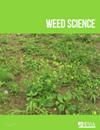Investigations into Differential Glyphosate Sensitivity between Two Horseweed (Conyza Canadensis) Growth Types
IF 2.1
2区 农林科学
Q2 AGRONOMY
引用次数: 0
Abstract
Abstract Horseweed [Conyza canadensis (L.) Cronquist] grows in one of two distinct growth phenotypes, “rosette” and “upright” growth types, and they have recently been observed co-occurring in Michigan fields. Previous research found that upright plants from two glyphosate-resistant populations were 3- and 4-fold less sensitive to glyphosate than their rosette siblings. Further experiments were conducted to investigate whether differential glyphosate sensitivity of the growth types was due to glyphosate retention, absorption, or translocation. The total amount of glyphosate retained on the C. canadensis leaf surface was similar for both growth types; however, on a per-weight and per-area bases, the upright growth type retained 21% and 18% less glyphosate, respectively. Glyphosate absorption was up to 85% at 168 h after treatment (HAT), and was not different between the rosette and upright growth types or between the susceptible (S) and resistant (R) biotypes. Additionally, there was no difference in translocation between the two growth types within each biotype at any time point. Interestingly, at 168 HAT, [14C]glyphosate translocation was higher in the S rosette compared with the two growth types from the R biotype; however, the S upright type was similar to both R growth types. Thus, glyphosate resistance in the R biotype may be due to an alternative mechanism rather than impaired translocation, which has been cited as the primary mechanism of glyphosate resistance in C. canadensis. These results suggest that reduced glyphosate retention on a per-weight and per-area bases of the upright growth type may contribute to increased glyphosate tolerance due to a diluted concentration of glyphosate in the plant. However, another factor is likely related to the mechanism of resistance within the R biotype, which is contributing to a 3-fold difference in glyphosate sensitivity between the two growth types, such as alterations in EPSPS gene expression or changes in undescribed metabolism genes.两种生长类型加拿大稻对草甘膦敏感性差异的研究
摘要:加拿大玉米(Conyza canadensis(L.)Cronquist]生长在两种不同的生长表型之一,即“玫瑰花结”和“直立”生长类型,最近观察到它们在密歇根州的田地中共存。先前的研究发现,来自两个草甘膦抗性群体的直立植物对草甘膦的敏感性是其玫瑰花结兄弟植物的3倍和4倍。进行了进一步的实验,以研究生长类型的草甘膦敏感性差异是否是由于草甘膦的保留、吸收或转运。对于两种生长类型,保留在加拿大C.canadensis叶片表面的草甘膦总量相似;然而,在单位重量和单位面积的基础上,直立生长型分别保留了21%和18%的草甘膦。草甘膦吸收在处理(HAT)后168小时高达85%,玫瑰花结型和直立生长型之间或敏感(S)和抗性(R)生物型之间没有差异。此外,在任何时间点,每种生物类型中的两种生长类型之间的易位都没有差异。有趣的是,在168 HAT时,与R生物型的两种生长类型相比,S玫瑰花结中[14C]草甘膦易位更高;然而,S直立型与两种R生长型相似。因此,R生物型的草甘膦抗性可能是由于一种替代机制,而不是易位受损,这被认为是加拿大C.canadensis草甘膦抗性的主要机制。这些结果表明,由于草甘膦在植物中的稀释浓度,草甘膦在直立生长型的单位重量和单位面积基上的保留减少可能有助于提高草甘膦耐受性。然而,另一个因素可能与R生物型内的抗性机制有关,这导致了两种生长类型之间草甘膦敏感性的3倍差异,例如EPSPS基因表达的变化或未描述的代谢基因的变化。
本文章由计算机程序翻译,如有差异,请以英文原文为准。
求助全文
约1分钟内获得全文
求助全文
来源期刊

Weed Science
农林科学-农艺学
CiteScore
4.60
自引率
12.00%
发文量
64
审稿时长
12-24 weeks
期刊介绍:
Weed Science publishes original research and scholarship in the form of peer-reviewed articles focused on fundamental research directly related to all aspects of weed science in agricultural systems. Topics for Weed Science include:
- the biology and ecology of weeds in agricultural, forestry, aquatic, turf, recreational, rights-of-way and other settings, genetics of weeds
- herbicide resistance, chemistry, biochemistry, physiology and molecular action of herbicides and plant growth regulators used to manage undesirable vegetation
- ecology of cropping and other agricultural systems as they relate to weed management
- biological and ecological aspects of weed control tools including biological agents, and herbicide resistant crops
- effect of weed management on soil, air and water.
 求助内容:
求助内容: 应助结果提醒方式:
应助结果提醒方式:


